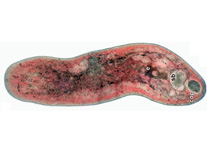Abstract
A new dwarf deep-water catshark, Bythaelurus tenuicephalus, is described based on one adult and one juvenile male specimen from off Tanzania and Mozambique in the western Indian Ocean. The new species differs from its congeners by its slender head and snout, which is only slightly bell-shaped in dorsoventral view without distinct lateral indention. All other Bythaelurus species have distinctly bell-shaped snouts with a strong lateral indention anterior to outer nostrils. Compared to its congeners in the western Indian Ocean, B. tenuicephalus n. sp. also has broader claspers in adult males (base width 2.1% TL vs. 1.5–1.8% TL). It further differs from B. clevai by attaining a smaller maximum size and having a color pattern of fewer and smaller blotches, larger oral papillae, a shorter snout, and broader claspers without knob-like apex and with a smaller envelope and a subtriangular (vs. subrectangular) exorhipidion. Compared to B. hispidus, the new species has a longer snout, a longer dorsal-caudal space, broader clasper without knob-like apex, and fewer vertebral centra. In contrast to B. lutarius, B. tenuicephalus attains a smaller maximum size and has a blotched (vs. largely plain) coloration, numerous (vs. lacking) oral papillae, shorter anterior nasal flaps, a longer caudal fin, a shorter pelvic anal space, and shorter and broader claspers.

